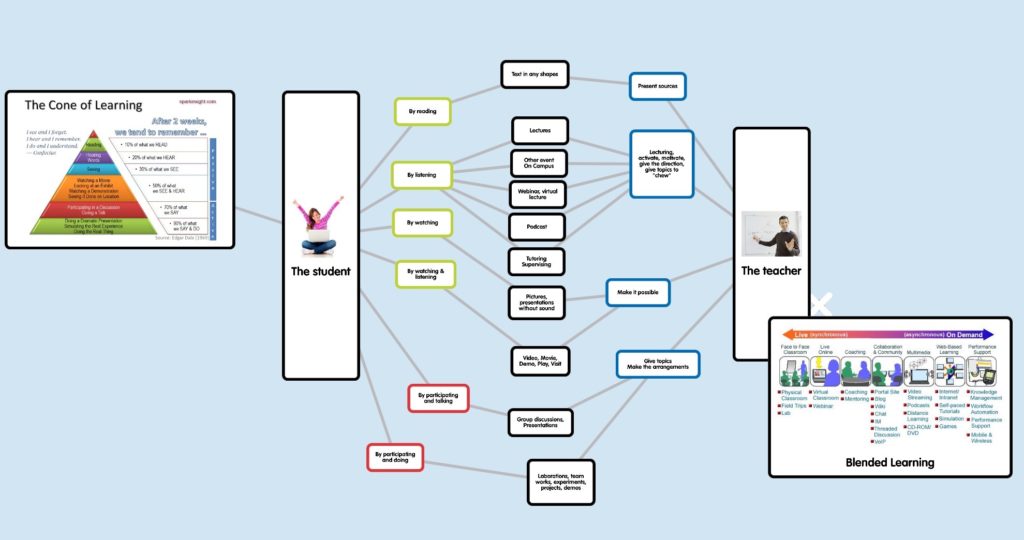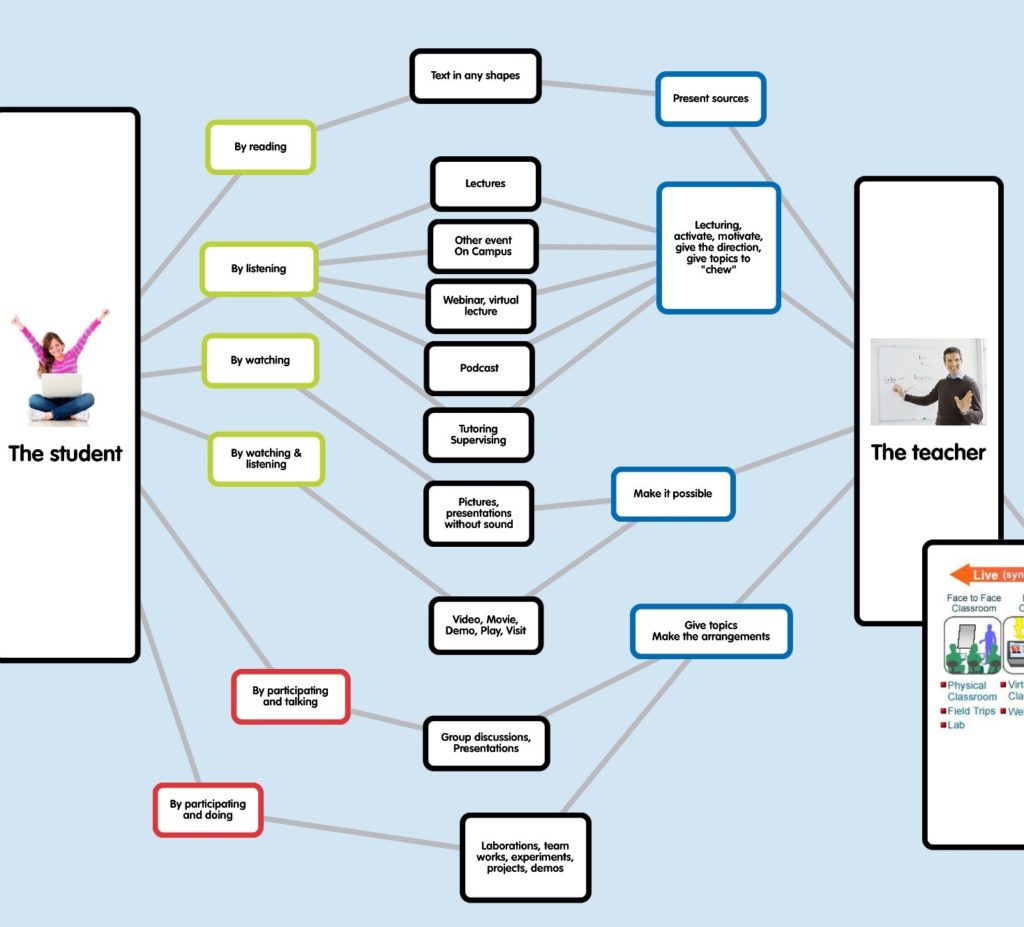CC BY 2.0 license – Credits to Denise Krebs.
“Education is not the filling of a pail, but the lighting of a fire.” W.B. Yeats
The Whole Picture
Those of you who read the previous article knows that I am on a journey where I want to challenge myself and my role as a teacher. Here are some of the questions that I hope to get answers on:
- Is it the teacher´s role to always be smarter and know more than the student?
- Do I always have to come up with answers if the student asks?
- Am I a bad teacher if I do not have all the answers?
- What is the difference between teaching and coaching?
- Are there any ways that the teacher could live up to the challenge of meeting different ways of learning in the same course?
- Is there any way to ensure that all students have the opportunity to learn?
- What kind of tools or principles might there be for us teachers to evoke the students’ thirst for knowledge and motivate them to focus on the currents topics?
These are major issues that need to be discussed and tackled to achieve results. I will try to find some answers here based on my experiences. My findings can thus be considered as a contribution to the discussion.
Let´s start with the whole picture, which you find in figure 1. The text is too small to read, I know, but that is not the point. The picture is there to illustrate that it is good to start from a helicopter view. You will find the details for further discussion in figure 2. This picture has been a guideline for me during my journey to become a better teacher. The process starts from left to right. We have a student eager to learn. As we already know students learn in different ways based on the Learning Pyramid (Lubos 2017). From right to left we have the teacher who will use his/her teaching skills to get results. The teacher has a “bag” full of teaching methodologies and tools to make it happen. Here the “bag” is symbolized by a black box called “Blended Learning”. This box will be subject for reflection in a later article. In the middle, we have the learning processes, in other words, the actual learning activities. Let us say that these rounded squares represent the different ways that the teacher makes it possible for the student to learn.

The Learning Process
I have adapted the Learning Pyramid and accepted that the students generally via learning activities remember 10% of what they read, 20% of what they hear, 30% of what they see, 50% of what they see and hear, 70% of what they say and write and 90% of what they do. It is also clear to me that the students will be able to “analyze, define, create and evaluate” (read: achieve deep learning) if they reach a learning rate of 70 – 90%. As a teacher at VAMK Universities of Applied Sciences, that should be the ultimate goal. Let us next analyze what the teacher can do to arrange the learning activities in such a way, that this could be achieved. Call it teaching if you want, but I prefer to call it learning to keep the focus on what the students need to do.

First up is “By reading”. The obvious way is to present written texts in any shape. It is up to the teacher to present current and relevant sources based on the course objectives and content. In most cases, the teacher presents a book, but it might also be articles or blog postings e.t.c. The teacher´s role is also to encourage critical thinking and even call for active searches for alternative sources. I will not go into the discussion about the number of pages nor the degree of difficulty, but I do want to point out that the teacher must, when planning the course, take into account the time it takes for a student to read, digest, and understand a mass of text
Next up is “By listening”. So, by offering sources for listening, you will increase the learning rate to 20%. Knowing this, you could conclude that audiobooks are more instructive than textbooks. However, I am not so sure about that. With audiobooks, you will lose the visual impression. Anyway, several activities include listening, like lectures, seminars, webinars, podcasts, tutoring, coaching, supervising, and others. These are probably the most used activities by teachers. In many of these activities, you will probably combine text, sound, and pictures and you will reach a learning rate of 50% if you succeed to keep the students focused.
Let´s stop here for a moment and get back to the role of the teacher. So far the process has been more focused on what the teacher does and less on the student. So, the top of the pyramid represents passive learning while the lower part represents active learning. In passive learning, the responsibility for the learning process is generally placed on the teacher. Why so, one could ask and the answer is probably, because “it has always been so”. In active learning, it is natural for students to take responsibility for their learning. There is a huge difference here. In passive learning, it is often up to the teacher to present sources, give lectures, activate, motivate, give instructions, and follow up. I’m not saying that this not should be a part of a teacher’s job, however, the time spent on lecturing could be replaced by more coaching. The goal is to “force” the students to take ownership of their own learning.
So, let us focus for a moment on the learning activities “Participating in a discussion | Give a talk” (70%) and “Doing a dramatic presentation | Simulating the real experience| Doing the real thing” (90%). The percentages referring to how much of the content “the student tend to remember, after 2 weeks” (read: learn). What kind of learning activities could we/I as a teacher arrange in order to maximize the learning outcome? In this case, I will not discuss the quality nor adequacy of the learning material itself. I will focus on the process and assume that the theory material presented is in order. Should I use only the learning methods in the bottom of the Learning Pyramid all the time for all my students? The answer is, of course, that the students need different learning activities in different situations, so as a teacher I should use all the levels of the pyramid, but still be aware of the difference in what “one tends to remember”.
Back to the point. How could I, as a teacher, get students participating and talking? The natural way would be to arrange group discussions and presentations. However, these are not always so popular among students. Furthermore, these kinds of learning activities are requiring more work by the teacher. I will not get into the discussion of time resources, but this might still be the reason why it is easier for a teacher to stick to “just” lecturing and expect the students to learn. I think that there are a lot of different learning methods in the tool box “Blended Learning” that could be used in order to intensify the learning process. There are many useful methods “out there”. For the teacher, it might often be about moving outside his/her comfort zone and implementing new ways of teaching. I hope that I will have the opportunity to get back to some of these methods in a later article. Meanwhile, if you would take some time to search the Internet for “learning methods for blended learning”, I am quite sure that you will find a lot of interesting articles to benefit from.
The students learn best by “participating and doing”. Some examples of good practice on this level are laborations, team work, experiments, individual tasks, project assignments and demonstrations. There are a lot of substances where these learning methods proof useful, especially when the skill sought is complex and the learning process is time-consuming, e.g. programming, database management or why not project management. We are finally getting to the main point of this article, namely to the conclusions and the way I have set up my courses and my teaching (read: the learning process for the students). This has taken me several years and the method has been developed in small steps. It is a question of an educational method and I have integrated the method also technically into the learning platform that we use at VAMK, which is Moodle. I use the term Task Oriented Learning (TOL). If you google, you will most likely find some hits. However, I have not done any research on the subject. I have found out that the method can be used both in on-campus and off-campus (online) courses. I actually discovered during 2020 when the COVID-19 pandemic ravaged the worst, that it was relatively easy to adapt an on-campus course to online teaching.
Task Oriented Learning
My inspiration for developing this way of teaching originates from the paper “Blueprints for Complex Learning: The 4C/ID-Model” (Jeroen J. G. van Merriënboer, et al. 2002). The most important for me in that paper is the 4C, the four components: (a) learning tasks, (b) supportive information, (c) just-in-time information and (d) part-task practice. During my auscultation, which I did rather late in my teaching carreer, I was already in on these thoughts, but the work left on paper. To give you an idea of how it works, I will here explain how my course in project management for 5 credit units is structured.
The students earn points for everything that they do. One expected hour of work means 1 point. For five credit units, that would mean 5 x 27 h = 135 h = 135 points. The learning activities involve small weekly task, larger assignments, self tests, a pre reflection and a post reflection and in this course also a team assignment. When planning for the course, the teacher needs to decide on the activities and estimate the time required for each activity and consequently score each activity separately. This will decide the workload of the course. It is important to to make sensible estimates of the number of points, and not to forget that reading and assimilating theory takes time. The points are known to the students right from the beginning together with a fairly accurate schedule for all the deadlines involved. To get the maximum points everything has to be submitted and handed in on time. Late submissions will mean point deductions.
The course is divided into logical manageable parts of a duration of 2 weeks. The idea is that the students focus on the current topic during that time and do the learning activities and after that move on to the next part. For the assignments and self tests there are two kind of deadlines: (1) an actual deadline and (2) a cut-off-date. After the cut-off-date the assignment will be closed, but can be re-opened on request. However, that will mean point deductions. Each part has theory sections to take in, in form of reading chapters in a book, watching video clips, or reading other current links. Each part forms its own whole with learning goals, which are clearly formulated and visible to the students. There are clear instructions for what is expected and what to do. This means also that the course works as a self-directed course. In fact the first phase with individual parts is realized 100% online. During the second phase, when we the students form teams and are taking on the team assignment, there are workshops to help the teams to get started. These are arranged face-to-face or as online workshops.
So, everything the student do within the course will result in points. Vice versa, what is not done will be discovered in points loss. The students are requested to study and work on the learning activities during the whole course. The activities are graded as the course progresses, some by the teacher and some automatically, and the achieved points are at hand at all times. The students know how to contact the teacher, who is present by giving comments and feedback on the pre-selected activities.
Some of the activities are mandatory, others not, but if the student want to achieve the highest grade, he/she should achieve at least 94% of the total points. There is a minimum point limit for different types of activities to pass the course. The more points, the better the final grade. It is as simple as that. The assessment method is based on the total points achieved and is given on a scale from 0 – 5, where 0 is a fail and 5 is the highest grade. The same relative scale, shown below, is always used, regardless of the number of credit units for the course. The amount of achievable total points differs, of course, depending on the extent of the course.
Final grade | Achieved percentage of maximum points
5 | higher than or equel to 94%
4 | between 85% and 94%
3 | between 75% and 84%
2 | between 65% and 74%
1 | between 55% and 64%
0 | lower than or equal to 55%
Summary
As a conclusion, I claim that by structuring the course in logical and manageable parts and giving the students clear instructions and enough time to read and digest the content and furthermore doing associated activities on an ongoing basis, knowing the assessment criteria from the start, I will help and motivate the students to achieve their learning goal. Note also, that this method allows students to set and achieve their own level of ambition when it comes to the final grade. I see this as a real bonus for the students.
The feedback from the students has mostly been positive, which I am particularly pleased with. The good part for me as a teacher is that I am able to entirely manage this technically in the learning platform (Moodle) and the final grading is a piece of cake. I hope to get back to the technical execution later in this same forum.




